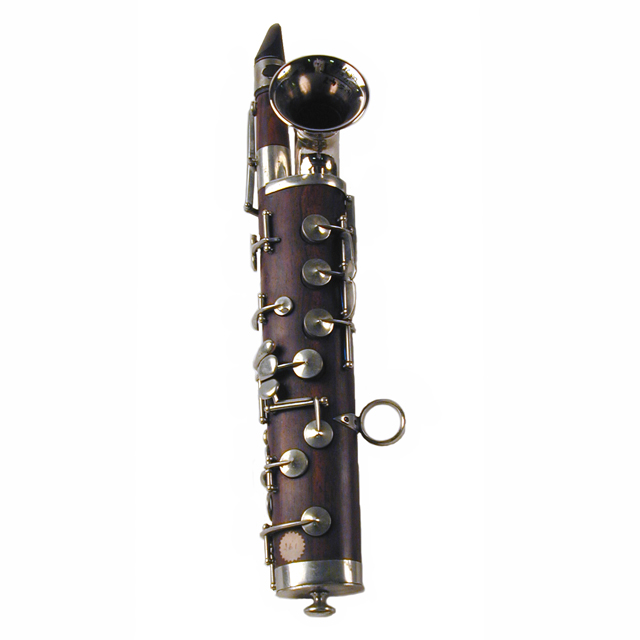Octavin
Woodwinds
Europe
Between 1001 and 1900 AD
Video
The Octavin is a type of woodwind instrument classified as a single-reed aerophone. The Octavin (also spelled Oktavin) is a unique woodwind instrument that emerged in the 19th century.
Instrument Characteristics
- The Octavin is classified as a single-reed aerophone, meaning it produces sound through a single reed similar to that found in clarinets and saxophones.
- It features a conical bore, which allows for a warm and rich sound. The shape of the Octavin resembles that of a bassoon, consisting of two parallel straight sections joined at the bottom, with the mouthpiece attached to one section and a metal bell at the top of the other.
- The written range of the Octavin extends from G♯3 to G6, making it comparable in range to that of a soprano saxophone. It was produced in various keys, including B♭, C, and F.
- The body of the Octavin is typically made from wood, which contributes to its tonal qualities. Some models may have metal components, particularly in the bell.
Invention and Development
The Octavin was first built byJulius Jehring, a bassoon maker, in 1881 in Adorf, Germany. Jehring initially called it the schnabeloboe due to its design and characteristics.
The instrument was later patented by Oskar Adler and Hermann Jordan in 1893. They renamed it the Octavin and marketed it as “das Deutsche Saxofon” (the German saxophone) to compete with Adolphe Sax’s saxophone.
The Octavin features a folded conical bore that resembles the boot joint of a bassoon, with a mouthpiece attached to one section and a metal bell at the top of another. It typically has 14 touch pieces and 3 rings, allowing for a range up to written C#.
Historical Context
Despite its innovative design, the Octavin did not gain widespread popularity and is now considered an extremely rare instrument. It has been noted for its unusual construction and limited repertoire. In modern times, the American composer Jeff Britting has composed works for the Octavin, contributing to its historical documentation and appreciation among collectors.
Instrument Mechanics
Structure
The Octavin features a folded conical bore, which resembles the boot joint of a bassoon. It consists of two parallel straight sections joined at the bottom. The mouthpiece is attached to the top of one section, while a metal bell is affixed to the top of the other. The instrument uses a single reed, similar to that found in clarinets and saxophones. This reed vibrates when air is blown through it, producing sound.
Sound Production
When a musician blows air into the mouthpiece, the airflow causes the single reed to vibrate. This vibration generates sound waves that travel through the body of the instrument.
The Octavin has multiple finger holes that can be covered or uncovered by the player’s fingers. By changing which holes are covered, the effective length of the vibrating air column is altered, allowing for different pitches to be produced. The written range of the Octavin extends from G♯3 to G6, making it comparable to a soprano saxophone in terms of pitch range. It was produced in various keys, including B♭, C, and F.
Fingering System
The fingering system of the Octavin is somewhat between that of an Albert-system clarinet and a military-system oboe. This unique fingering allows for versatility in playing and facilitates transitions between notes.
FAQ
What is the range of the Octavin?
The octavin has a range of approximately two and a half octaves, similar to that of the soprano saxophone or clarinet. Its pitch is typically in C or B-flat, depending on the model. The instrument produces a reedy, nasal tone, with its higher register resembling a shawm and its lower register similar to an oboe d’amore.
Why did the Octavin fail to gain popularity?
The octavin failed to gain popularity due to its nasal tone, which was less versatile and appealing compared to other woodwinds like the clarinet or oboe. Its complex keywork and awkward ergonomics made it difficult to play, deterring musicians.
What challenges did players face when using the Octavin?
Players of the octavin faced several challenges, including its awkward keywork, which made finger placement and transitions difficult. Its unique tonal quality—a nasal, reedy sound—required precise control to produce a desirable tone, limiting its versatility. The unconventional bore design could lead to intonation issues, demanding advanced breath and embouchure control.
What materials were used in the construction of the Octavin?
The octavin was typically constructed from wood, such as grenadilla or boxwood, which provided a resonant and durable body. Its keys were made of metal, often nickel silver or brass, ensuring precision and durability in the mechanism. The mouthpiece resembled that of a clarinet and was made from similar materials, such as ebonite or hard rubber, paired with a cane reed.
 Links
Links
References
Other Instrument
Categories


















